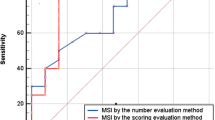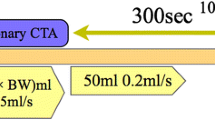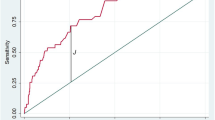Abstract
The present study investigated the clinical value of myocardial contrast-delayed enhancement (DE) with multidetector computed tomography (MDCT) without iodine re-injection immediately after primary percutaneous coronary intervention (PCI) for predicting future cardiovascular events after acute myocardial infarction (AMI). We performed a prospective study in which 263 consecutive patients with first AMI successfully treated with primary PCI were enrolled. Sixty-four-slice MDCT without the re-injection of contrast medium was performed immediately after PCI. Myocardial DE was considered to be transmural when involving myocardial thickness ≥ 75% (Group A; n = 104), subendocardial (< 75%, Group B; n = 108), or normal (Group C; n = 51). A semiquantitative scale score was defined for 17 left ventricular segments to investigate the extent of the DE area assessed. We examined the relationship between the presence or absence of transmural DE and long-term cardiovascular event rates. The median follow-up period was 3.5 years. Kaplan–Meier survival curves showed that patient prognosis was poorer in the group with Group A than that in the group with Group B, which was equivalent to that with Group C. A multivariate analysis identified the presence of transmural DE as the strongest predictor for future cardiovascular events (hazard ratio: 3.7; P = 0.023). Transmural myocardial DE immediately following primary PCI without an iodine re-injection for AMI is a major risk factor for future cardiovascular events.


Similar content being viewed by others
Data availability
The deidentified participant data will be shared on a request basis. Please directly contact the corresponding author to request data sharing. Data will be available during the 9–24 months after the publication.
References
Rochitte CE, Lima JA, Bluemke DA, Reeder SB, McVeigh ER, Furuta T, Becker LC, Melin JA (1998) Magnitude and time course of microvascular obstruction and tissue injury after acute myocardial infarction. Circulation 98(10):1006–1014
Wu KC, Zerhouni EA, Judd RM, Lugo-Olivieri CH, Barouch LA, Schulman SP, Blumenthal RS, Lima JA (1998) Prognostic significance of microvascular obstruction by magnetic resonance imaging in patients with acute myocardial infarction. Circulation 97(8):765–772
Kloner RA, Ganote CE, Jennings RB (1974) The “no-reflow” phenomenon after temporary coronary occlusion in the dog. J Clin Invest 54(6):1496–1508
Bates ER, Krell MJ, Dean EN, O’Neill WW, Vogel RA (1986) Demonstration of the “no-reflow” phenomenon by digital coronary arteriography. Am J Cardiol 57(1):177–178
Gibson CM, Cannon CP, Daley WL, Dodge JT, Alexander B Jr, Marble SJ Jr, McCabe CH, Raymond L, Fortin T, Poole WK, Braunwald E (1996) TIMI frame count: a quantitative method of assessing coronary artery flow. Circulation 93(5):879–888
Ito H, Maruyama A, Iwakura K, Takiuchi S, Masuyama T, Hori M, Higashino Y, Fujii K, Minamino T (1996) Clinical implications of the “no reflow” phenomenon. A predictor of complications and left ventricular remodeling in reperfused anterior wall myocardial infarction. Circulation 93(2):223–228
Kawamoto T, Yoshida K, Akasaka T, Hozumi T, Takagi T, Kaji S, Ueda Y (1999) Can coronary blood flow velocity pattern after primary percutaneous transluminal coronary angioplasty [correction of angiography] predict recovery of regional left ventricular function in patients with acute myocardial infarction? Circulation 100(4):339–345
Yamamuro A, Akasaka T, Tamita K, Yamabe K, Katayama M, Takagi T, Morioka S (2002) Coronary flow velocity pattern immediately after percutaneous coronary intervention as a predictor of complications and in-hospital survival after acute myocardial infarction. Circulation 106(24):3051–3056
Goto K, Takagi A, Arai K, Yamaguchi J, Hagiwara N (2010) Noninvasive assessnent of mocardial damage after acute anterior myocardial infarction: myocardila blush grade in conjunction with analysis of coronary flow pattern. Heart Vessels 25(4):299–305
Ndrepepa G, Tiroch K, Fusaro M, Keta D, Seyfarth M, Byrne RA, Pache J, Alger P, Mehilli J, Schomig A, Kastrati A (2010) 5-year prognostic value of no-reflow phenomenon after percutaneous coronary intervention in patients with acute myocardial infarction. J Am Coll Cardiol 55(21):2383–2389
Beek AM, Nijveldt R, van Rossum AC (2010) Intramyocardial hemorrhage and microvascular obstruction after primary percutaneous coronary intervention. Int J Cardiovasc Imaging 26(1):49–55
Friedrich MG, Abdel-Aty H, Taylor A, Schulz-Menger J, Messroghli D, Dietz R (2008) The salvaged area at risk in reperfused acute myocardial infarction as visualized by cardiovascular magnetic resonance. J Am Coll Cardiol 51(16):1581–1587
Francone M, Bucciarelli-Ducci C, Carbone I, Canali E, Scardala R, Calabrese FA, Sardella G, Mancone M, Catalano C, Fedele F, Passariello R, Bogaert J, Agati L (2009) Impact of primary coronary angioplasty delay on myocardial salvage, infarct size, and microvascular damage in patients with ST-segment elevation myocardial infarction: insight from cardiovascular magnetic resonance. J Am Coll Cardiol 54(23):2145–2153
Kim HW, Farzaneh-Far A, Kim RJ (2009) Cardiovascular magnetic resonance in patients with myocardial infarction: current and emerging applications. J Am Coll Cardiol 55(1):1–16
Eitel I, Desch S, Fuernau G, Hildebrand L, Gutberlet M, Schuler G, Thiele H (2010) Prognostic significance and determinants of myocardial salvage assessed by cardiovascular magnetic resonance in acute reperfused myocardial infarction. J Am Coll Cardiol 55(22):2470–2479
Habis M, Capderou A, Ghostine S, Daoud B, Caussin C, Riou JY, Brenot P, Angel CY, Lancelin B, Paul JF (2007) Acute myocardial infarction early viability assessment by 64-slice computed tomography immediately after coronary angiography: comparison with low-dose dobutamine echocardiography. J Am Coll Cardiol 49(11):1178–1185
Sato A, Hiroe M, Nozato T, Hikita H, Ito Y, Ohigashi H, Tamura M, Takahashi A, Isobe M, Aonuma K (2008) Early validation study of 64-slice multidetector computed tomography for the assessment of myocardial viability and the prediction of left ventricular remodelling after acute myocardial infarction. Eur Heart J 29(4):490–498
Gerber BL, Belge B, Legros GJ, Lim P, Poncelet A, Pasquet A, Gisellu G, Coche E, Vanoverschelde JL (2006) Characterization of acute and chronic myocardial infarcts by multidetector computed tomography: comparison with contrast-enhanced magnetic resonance. Circulation 113(6):823–833
Baks T, Cademartiri F, Moelker AD, Weustink AC, van Geuns RJ, Mollet NR, Krestin GP, Duncker DJ, de Feyter PJ (2006) Multislice computed tomography and magnetic resonance imaging for the assessment of reperfused acute myocardial infarction. J Am Coll Cardiol 48(1):144–152
Watabe H, Sato A, Nishina H, Hoshi T, Sugano A, Kakefuda Y, Takaiwa Y, Aihara H, Fumikura Y, Noguchi Y, Aonuma K (2016) Enhancement patterns detected by multidetector computed tomography are associated with microvascular obstruction and left ventricular remodelling in patients with acute myocardial infarction. Eur Heart J 37(8):684–692
Kim RJ, Chen EL, Lima JA, Judd RM (1996) Myocardial Gd-DTPA kinetics determine MRI contrast enhancement and reflect the extent and severity of myocardial injury after acute reperfused infarction. Circulation 94(12):3318–3326
Tarantini G, Razzolini R, Cacciavillani L, Bilato C, Sarais C, Corbetti F, Marra MP, Napodano M, Ramondo A, Iliceto S (2006) Influence of transmurality, infarct size, and severe microvascular obstruction on left ventricular remodeling and function after primary coronary angioplasty. Am J Cardiol 98(8):1033–1040
Weir RA, Murphy CA, Petrie CJ, Martin TN, Balmain S, Clements S, Steedman T, Wagner GS, Dargie HJ, McMurray JJ (2010) Microvascular obstruction remains a portent of adverse remodeling in optimally treated patients with left ventricular systolic dysfunction after acute myocardial infarction. Circ Cardiovasc Imaging 3(4):360–367
Sato A, Nozato T, Hikita H, Akiyama D, Nishina H, Hoshi T, Aihara H, Kakefuda Y, Watabe H, Hiroe M, Aoyama K (2012) Prognostic value of myocardial contrast delayed enhancement with 64-slice multidetector computed tomography after acute myocardial infarcion. J Am Coll Cardiol 59(8):730–738
TIMI Study Group (1985) The Thrombolysis in Myocardial Infarction (TIMI) trial. Phase I findings. N Engl J Med 312(14):932–936
Rentrop KP, Thornton JC, Feit F, Van Buskirk M (1988) Determinants and protective potential of coronary arterial collaterals as assessed by an angioplasty model. Am J Cardiol 61(10):677–684
Gibson CM, Cannon CP, Murphy SA, Ryan KA, Mesley R, Marble SJ, McCabe CH, Van De Werf F, Braunwald E (2000) Relationship of TIMI myocardial perfusion grade to mortality after administration of thrombolytic drugs. Circulation 101(2):125–130
Cerqueira MD, Weissman NJ, Dilsizian V, Jacobs AK, Kaul S, Laskey WK, Pennell DJ, Rumberger JA, Ryan T, Verani MS (2002) American Heart Association Writing Group on Myocardial, and I. Registration for Cardiac, Standardized myocardial segmentation and nomenclature for tomographic imaging of the heart. A statement for healthcare professionals from the Cardiac Imaging Committee of the Council on Clinical Cardiology of the American Heart Association. Circulation 105(4):539–542
Ho KK, Anderson KM, Kannel WB, Grossman W, Levy D (1993) Survival after the onset of congestive heart failure in Framingham Heart Study subjects. Circulation 88(1):107–115
Lardo AC, Cordeiro MA, Silva C, Amado LC, George RT, Saliaris AP, Schuleri KH, Fernandes VR, Zviman M, Nazarian S, Halperin HR, Wu KC, Hare JM, Lima JA (2006) Contrast-enhanced multidetector computed tomography viability imaging after myocardial infarction: characterization of myocyte death, microvascular obstruction, and chronic scar. Circulation 113(3):394–404
Costantini CO, Stone GW, Mehran R, Aymong E, Grines CL, Cox DA, Stuckey T, Turco M, Gersh BJ, Tcheng JE, Garcia E, Griffin JJ, Guagliumi G, Leon MB, Lansky AJ (2004) Frequency, correlates, and clinical implications of myocardial perfusion after primary angioplasty and stenting, with and without glycoprotein IIb/IIIa inhibition, in acute myocardial infarction. J Am Coll Cardiol 44(2):305–312
Habis M, Capderou A, Sigal-Cinqualbre A, Ghostine S, Rahal S, Riou JY, Brenot P, Angel CY, Paul JF (2009) Comparison of delayed enhancement patterns on multislice computed tomography immediately after coronary angiography and cardiac magnetic resonance imaging in acute myocardial infarction. Heart 95(8):624–629
Stone GW, Cox D, Garcia E, Brodie BR, Morice MC, Griffin J, Mattos L, Lansky AJ, O’Neill WW, Grines CL (2001) Normal flow (TIMI-3) before mechanical reperfusion therapy is an independent determinant of survival in acute myocardial infarction: analysis from the primary angioplasty in myocardial infarction trials. Circulation 104(6):636–641
Gibson CM, Cannon CP, Murphy SA, Marble SJ, Barron HV, Braunwald E, TIMI Study Group (2002) Relationship of the TIMI myocardial perfusion grades, flow grades, frame count, and percutaneous coronary intervention to long-term outcomes after thrombolytic administration in acute myocardial infarction. Circulation 105(16):1909–1913
Saito D, Nakanishi R, Watanabe I, Yabe T, Okubo R, Amano H, Toda M, Ikeda T (2018) Combined assessment of left ventricular end-diastolic pressure and ejection fraction by left ventriculography predicts long-term outcomes of patients with ST-segment elevation myocardila infarction. Heart Vessels 33(5):453–461
Acknowledgements
We gratefully thank Medical English Service (Kyoto, Japan) for their critical reading of the English in the manuscript.
Author information
Authors and Affiliations
Contributions
KT.: performed statistical analyses. MY: handled supervision. KT, YA, HH, MM, TT: acquired data. KT: conceived and designed the research and drafted the manuscript. YI and HH: made critical revisions of the manuscript for key intellectual content.
Corresponding author
Ethics declarations
Conflict of interest
The authors declare that they have no known competing financial interests or personal relationships that could have appeared to influence the work reported in this paper.
Ethical approval
This study was conducted in compliance with the Declaration of Helsinki and approved by the Committee for the Protection of Human Subjects in Research (reference number: 20091201) at the Nishinomiya Watanabe Cardiovascular Center.
Additional information
Publisher's Note
Springer Nature remains neutral with regard to jurisdictional claims in published maps and institutional affiliations.
Rights and permissions
About this article
Cite this article
Tamita, K., Yamamuro, A., Hashimura, H. et al. Enhancement patterns detected by multidetector computed tomography are associated with the long-term prognosis of patients with acute myocardial infarction. Heart Vessels 36, 1784–1793 (2021). https://doi.org/10.1007/s00380-021-01868-1
Received:
Accepted:
Published:
Issue Date:
DOI: https://doi.org/10.1007/s00380-021-01868-1




